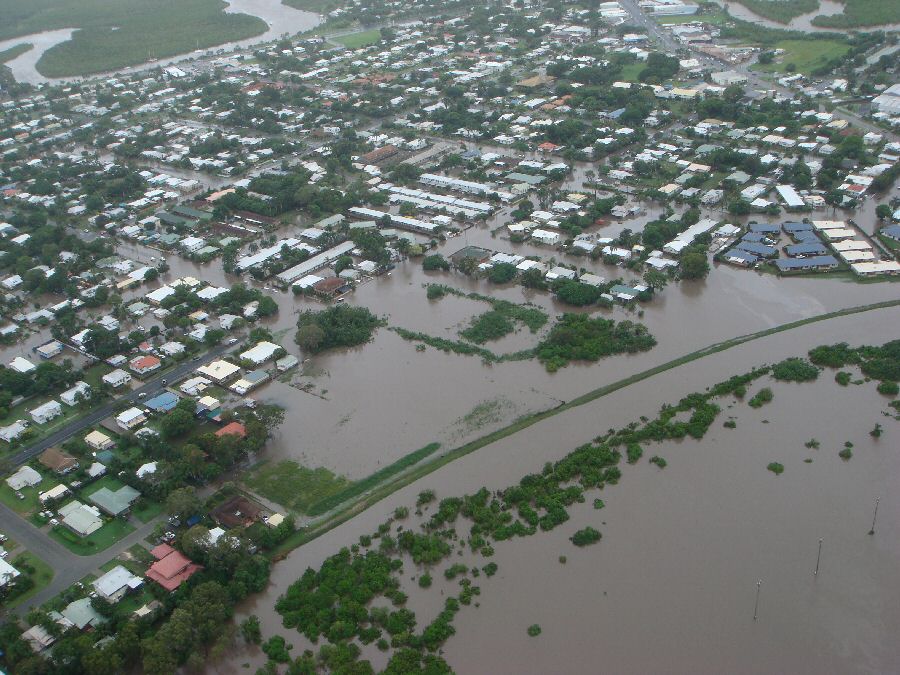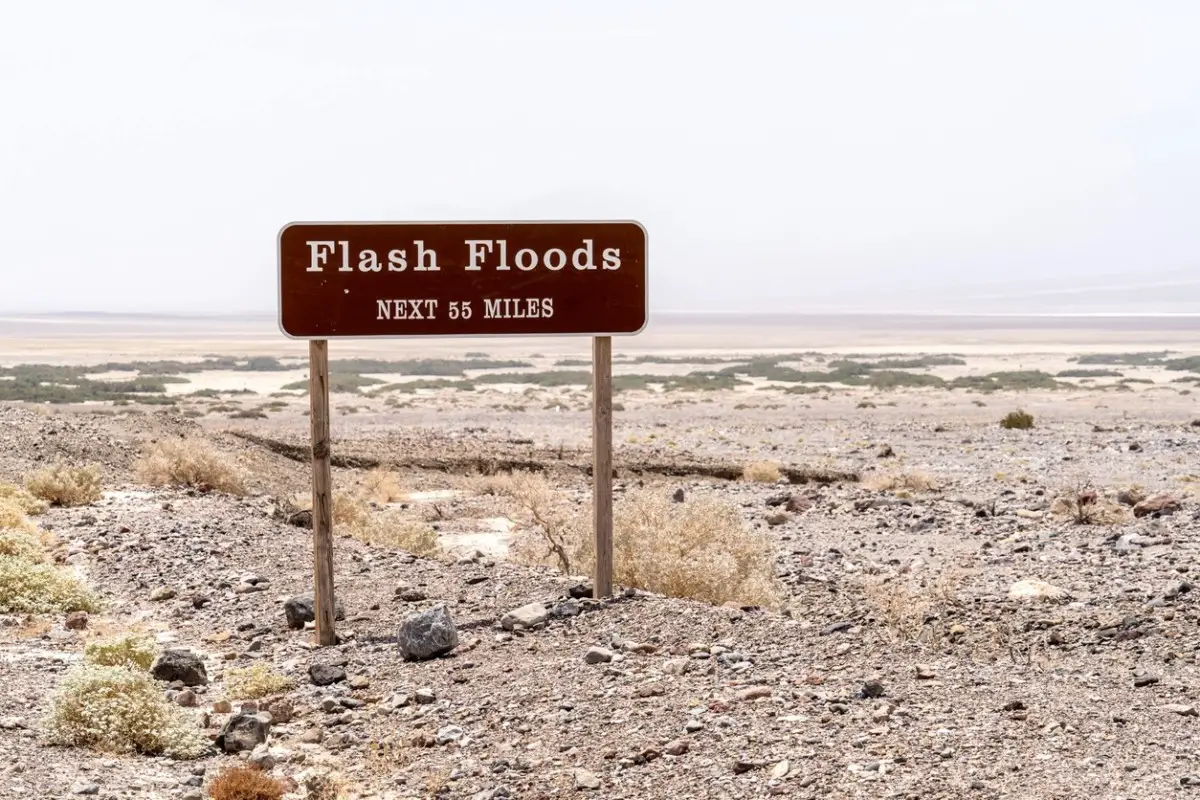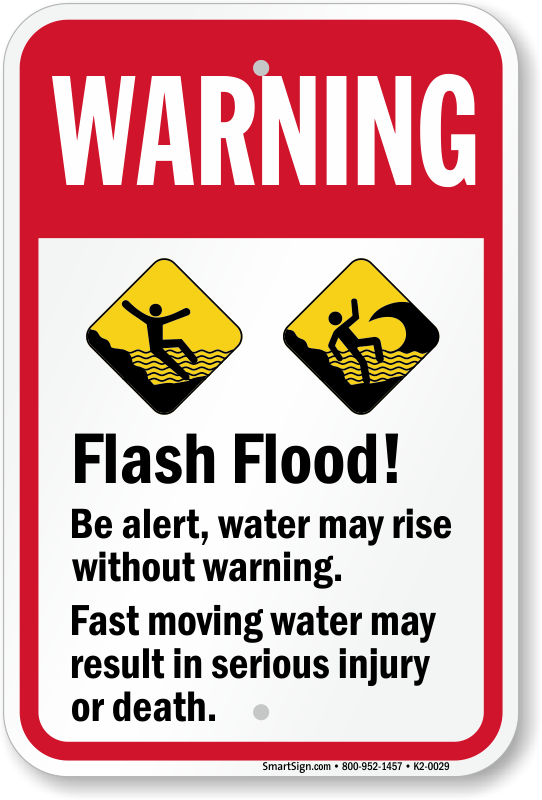Flash Floods can happen with little time to escape even though there are two types of alerts for flash floods issued by the National Weather Service, one is a flash flood watch which means that conditions are favorable for flash flooding and the other is a flash flood warning. What is a Flash Flood Warning?
A Flash flood warning is an alert issued by the National Weather Service that indicates that a flash flood that can take minutes to hours to develop is occurring or will occur imminently and is usually issued when there are strong weather radar echoes for an area that is prone to flash flooding.
If you are in a flood-prone area move immediately to high ground. A flash flood is a sudden violent flood that can take from minutes to hours to develop. It is even possible to experience a flash flood in areas not immediately receiving rain.
Introduction:
Imagine relaxing in your home only to hear a menacing warning over the radio, “Flash Flood Warning!” These phrases, disconcerting as they may be, are critical lifesavers in times of natural disaster. But what exactly is a Flash Flood Warning? Is it different from a Flood Warning?
And why does one matter to you? This article aims to unravel the mystery behind this term, its unique significance, and why paying heed to it could be the difference between safety and catastrophe. Immerse yourself in the critical world of weather warnings and gain knowledge that can quite literally save lives.
What is a Flash Flood Warning
A Flash flood is a specific type of flooding that occurs in a short time frame after a precipitation event generally less than six hours. It often is caused by heavy or excessive rainfall and happens in areas near rivers or lakes, but it also can happen in places with no water bodies nearby.
People in homes and businesses can be caught off guard by the speed of a Flash Flood.
- the intensity of the rainfall
- the location and distribution of the rainfall
- the land use and topography
- vegetation types and growth/density, soil type, and soil water content
These will be the factors that all determine just how quickly the Flash Flooding may occur, and influence where it may occur and how serious the Flash Flood will end up being. Remember that 66 % of Flash Flood fatalities happen to victims in their cars. Only 6 inches of water has the power to knock a person off their feet and only 2 ft of rainwater in a Flash Flood can float a vehicle.
Understanding What is a Flash Flood Warning
A flash flood warnings is an initial announcement made by the national weather agencies such as the NWS (National Weather Service) or NOAA (National Oceanic and Atmospheric Administration), noting that adverse weather conditions could cause severe flooding. The distinction between a flash flood watch and a flash flood warning is vital for our safety and emergency preparedness.
When a flash flood watch is announced, it’s a sign to stay alert because conditions are ripe for a possible flash flood occurrence. However, a flash flood warning, the focus of our information, means a flash flood is expected or already happening.
Basically, a flash flood warning is issued when a flash flood is imminent or occurring. It’s a form of alerts to keep you and your family safe, signalling that you might need to evacuate or move to safer ground immediately. It’s not just water we’re talking about here; it means an onslaught of extremely fast and powerful moving water that can cause massive destruction. So, receiving such warnings shouldn’t be taken lightly.
Further, understanding the terminology in these warnings can be life-saving. When you hear terms like ‘a flash flood is either imminent or occurring’, it doesn’t just express the possibility. No. It’s an authoritative government warning, informing the population that a dangerous and rapid influx of floodwater is a certainty, ready to happen any moment, or is already underway. Such flash flood warnings, consequently, necessitate immediate action.
If you ever receive a flash flood warning notification, it is imperative to act swiftly and follow recommended guidelines. You don’t want to be the person who underestimated the power of moving water or delayed action, as this goes beyond just protecting assets; it is about the protection of life.
Use these warnings to your advantage; use them to ensure the safety of your family and community. Aim to understand the difference between a watch and a warning, and always prioritize the safety procedures recommended by emergency services in your area in the face of a potential risk.
In essence, these warnings act as an emergency forecast, giving people enough time to prepare or evacuate if necessary. Remember, waiting until the last minute isn’t the best strategy when it comes to flash floods. The more information you have, and the sooner you have it, the safer you and your loved ones can be during such a catastrophe.

The Difference between a Flash Flood Watch and a Flash Flood Warning
If you’ve ever wondered the difference between a flash flood watch and a flash flood warning, you’re not alone. They’re easy to confuse, but understanding this crucial difference is vital to your safety. Like many aspects of weather service information, the key is all in the terminology.
In terms of national guidelines from the government’s weather services like NOAA.gov, a flash flood watch essentially means ‘be alert’. It’s the weather service’s way of saying that conditions are right for flash flooding to occur, but it hasn’t happened yet. The ‘watch’ part of ‘flash flood watch’ is quite literal – keep your eye on the situation, stay informed, and be prepared to act if a flash flood warning is issued.
On the contrary, a flash flood warning is far more urgent. This is not an advice to be alert, but instead, it’s the weather service emphatically stating: “it’s here, or it’s imminent, take action now!”
The moment you hear about a flash flood warning, you should be moving to higher ground or a safe area immediately. Going back to the difference between the two, a ‘flash flood watch’ tells us to get prepared, while a ‘flash flood warning’ means that a flood is either currently happening or is just about to occur.
Both warnings and the flash flood watch require different and immediate responses. It’s critical that you stay informed by turning to reliable sources that provide flash flood warnings and weather information, such as the National Weather Service or NOAA.gov.
On the subject of flash flood warnings, you might find yourself wondering, “why a ‘flash’ flood warning? What’s in a name?” The ‘flash’ in ‘flash flood warning’ refers to the velocity at which these destructive floods occur. Unlike normal flooding, which can take hours or even days to reach dangerous levels, flash floods are lightning-quick. Thunderstorms or heavy rainfall can trigger these fast-moving floods, which rise rapidly with little or no warning.
At the end of the day, understanding the difference between a flash flood watch and a flash flood warning can save your life. When it comes to it, take every piece of weather service information to heart.
Weather fronts are predictable to a certain degree, but nature’s course can change in an instant. Never dismiss an alert from NOAA.gov or your local weather service, but instead stay attuned to the latest flood warning and watch developments. Safety lies in awareness, so when you hear about a flash flood warning or watch, take it seriously – it could be a literal lifesaver.
Ground Conditions that cause Flash Flooding
When it comes to floods, certain areas are particularly susceptible, bringing the relevance of flash flood warning home or business is situated in one of these areas, it’s essential to understand the nature of flash flood warnings and their importance in safeguarding your life and property.
A flash flood warning is a crucial alert issued by national monitoring bodies like the NOAA when flash flooding is imminent or occurring. The necessity of these warnings cannot be overlooked, especially in areas prone to floods Such alerts are often dispatched via various channels to ensure that people have ample time to evacuate and secure their properties.
Flash floods can happen along rivers, on coastlines, in urban areas, and in dry creek beds. River floods generally happen when river basins fill too quickly and water pours over the banks. Flash flood warnings warn that a flash flood is either imminent or occurring already. Emergency coastal flooding is common when tropical storms or hurricanes drive ocean sea water inland, or when tsunamis send water surging onto into an area near the shore.
A Flash Flood is possible everywhere. The ordinarily tranquil streams and creeks in any area can become raging torrents if heavy rain falls overhead or even upstream of your location! Flash Flooding can also occur on city streets and highways and often under underpasses.
They also occur when rainwater normally fills dry creeks or streams or enough water accumulates for a stream or river to overtop their banks, causing rapid rises of water in a short amount of time where the ground can’t absorb it fast enough.
Urban flood areas won’t be able to absorb water from the flooding as fast or as much as an area in the country where there are fewer blacktop hard surfaces like streets and highways and more fields and grass.
If caught out in Flash Flood conditions never try and drive through the water but only move to higher ground and try to stay away from contact with the flood water typically flood water, especially Flash Flood water will be contaminated with sewage and other nasty pollutants.
Flash floods are remarkably sudden, and their high-velocity waters can cause widespread devastation within a short period. These floods occur mainly due to excessive rainfalls, landslides, or the failure of artificial water containment structures like dams.
The warnings to predict these floods are issued when flash flooding is imminent or occurring, allowing people to take necessary precautionary steps.
Areas prone to flash floods tend to have specific geographical features. For instance, regions near a river or along coastlines are more likely to encounter flash floods
Importantly, not all floods are flash floods. The difference lies in the development time. In contrast, regular floods might take a day or two to build up, flash floods can happen within a few hours or even minutes of heavy rain, hence the necessity of timely warnings
The significance of a flash flood warning is highlighted when we consider its role in saving lives and properties. Upon receiving a warning, one must immediately leave the area, moving to higher ground if possible. It’s especially crucial for those whose home or business is in a high-risk area. Such warnings allow you to safeguard your home and preserve your life.
The key to dealing with flash flood warnings and actual floods lies in understanding their nature, knowing the susceptible areas, and taking prompt action. A delay could mean more damage to your home and even threaten your life
Always remember, when a flash flood warning is issued, it’s not a situation you should take lightly. Swift, preventative action can protect your home, business, and most importantly, your life
Has it Ever Snowed in Florida?
Yes, but it is rare, for snowfall to occur in Florida, the polar jet stream has to move towards the south and into the Gulf of Mexico through Texas, move with a cold front across Southern Florida, and then curve towards the Northeast before combining with cooling air in the frontal clouds ..…………………………………………………………………….. Read more
Areas Most Prone to Flash Flood Warnings and Flooding
When it comes to floods, certain areas are particularly susceptible, bringing the relevance of flash flood warnings to the fore. If your home or business is situated in one of these areas, it’s essential to understand the nature of flash flood warnings and their importance in safeguarding your life and property.
A flash flood warning is a crucial alert issued by national monitoring bodies like the NOAA when flash flooding is imminent or occurring. The necessity of these warnings cannot be overlooked, especially in areas prone to floods. Such alerts are often dispatched via various channels to ensure that people have ample time to evacuate and secure their properties.
Flash floods are remarkably sudden, and their high-velocity waters can cause widespread devastation within a short period. These floods occur mainly due to excessive rainfalls, landslides, or the failure of artificial water containment structures like dams. The warnings to predict these floods are issued when flash flooding is imminent or occurring allowing people to take necessary precautionary steps.
Areas prone to flash floods tend to have specific geographical features. For instance, regions near a river or along coastlines are more likely to encounter flash floods
The significance of a flash flood warning is highlighted when we consider its role in saving lives and properties. Upon receiving a warning, one must immediately leave the area, moving to higher ground if possible. It’s especially crucial for those whose home or business is in a high-risk area.
The key to dealing with flash flood warnings and actual floods lies in understanding their nature, knowing the susceptible areas and taking prompt action. A delay could mean more damage to your home and even threaten your life
Flash Flood vs Flood


Flooding kills more people than just about any weather-related hazard. Most deaths associated with emergency floods occur either at night or when people become trapped in automobiles that stall while driving in areas that are flooded.
They are issued when a flash flood is imminent or already occurring during a flood warning or an initial announcement noting that weather conditions could cause flooding.
Floods flash happen before security systems can be divided into two general categories: flash floods and river floods. Both life-threatening home security alerts hold the potential and conditions for causing family death, injury, and property destruction.
Flash Floods are caused by heavy or excessive rainfall in a short period of time, generally less than 6 hours. They are typically characterized by raging torrents after heavy rains that rip through river beds, urban streets, or mountain canyons sweeping everything before them.
They can occur within minutes or a few hours of heavy rainfall. They can also occur even if no rain has fallen, for instance after a levee or dam has failed, or after a sudden release of water by a debris or ice jam.
A Flood is an overflow of water onto normally dry land making it even worse. The inundation of a normally dry area is caused by rising water in an existing waterway, like a river, stream, or drainage ditch.
Ponding of the rainwater at or near the point where the rain fell. Flooding is normally a longer-term event than flash flooding and it may last days or weeks. Flash Floods after flash flood warnings are the #1 cause of storm-related deaths in the US.
Conclusion:
Staying aware of flash flood warnings and understanding their relevance could mean the difference between life and death. By comprehending what a flash flood warning denotes, we can make informed decisions on taking immediate action or evacuation if necessary.
Always remember, your safety is paramount. When you receive a flash flood warning, take it seriously and plan accordingly. After all, it’s better to prepare and avoid the devastation of a flash flood, or any disaster than face unforeseen consequences.
A Seawall effectively acts as a form of coastal defense by redirecting the energy of a wave made by a storm surge back to the ocean water, protecting the coastline from flooding and reducing erosion of the beachfront ………………………………………………………………………………………………….. Read more

References:
Scientific American- What is a Flash Flood?
FAQ’s
Q: What is a Flash Flood Warning?
A: A flash flood warning is an announcement made by national weather agencies such as the NWS or NOAA noting that adverse weather conditions could cause severe flooding. It signifies that a flash flood is expected or is already occurring, and implies the necessity to evacuate or move to a safer location immediately.
Q: What is the difference between Flash Flood Watch and Flash Flood Warning?
A: A flash flood watch is a signal to stay alert as conditions are ripe for a flash flood, but it’s not yet certain to occur. A flash flood warning, on the other hand, is more urgent and means a flash flood is imminent or already happening, necessitating immediate action and potential evacuation.
Q: What happens when a flash flood warning is issued?
A: If a flash flood warning is issued, it denotes that a flash flood is imminent or already ongoing. This is a signal for you to move immediately to safer ground or evacuate if necessary. Ignoring such warnings can lead to disastrous consequences.
Q: How frequently do flash flood warnings come into effect?
A: As flash flood warnings are closely related to weather conditions, the frequency of these warnings depends on the prevailing weather and geographical location. They mostly occur in regions prone to heavy rainfall or those with certain ground conditions, such as areas with saturated ground due to previous rains or regions experiencing drought.
Q: Does the ground condition influence flash floods?
A: Yes, the condition of the ground plays a crucial role in influencing flash floods. Grounds that are oversaturated from previous rains or regions experiencing drought are particularly susceptible to flash flooding. The rainfall either doesn’t get absorbed due to saturation, or cannot be absorbed quickly due to hard, dry ground, leading to rapid flooding. These circumstances typically call for a flash flood warning to be issued.



